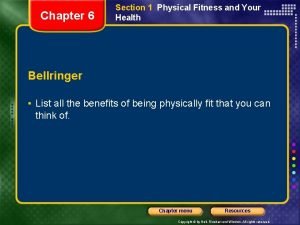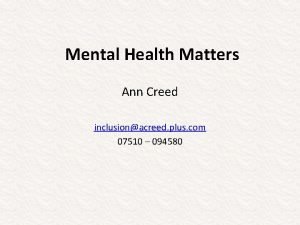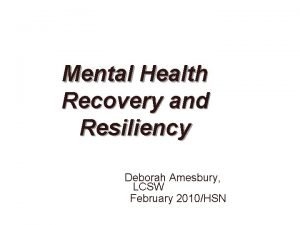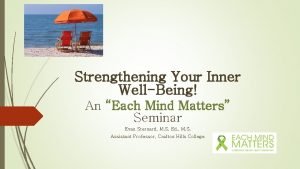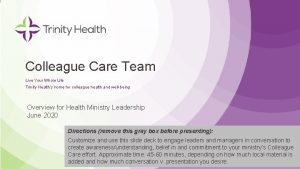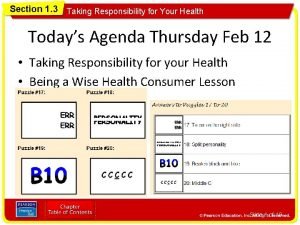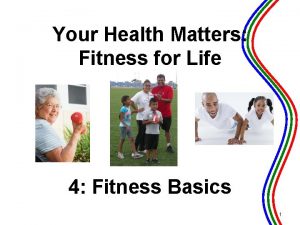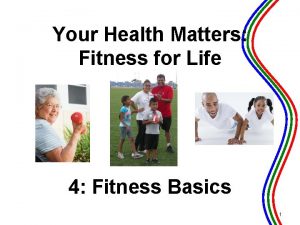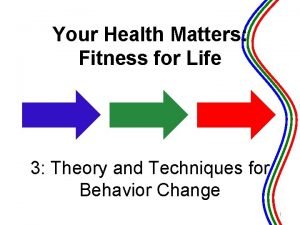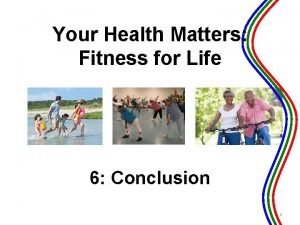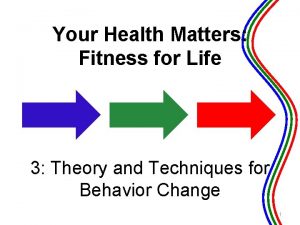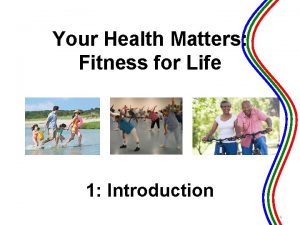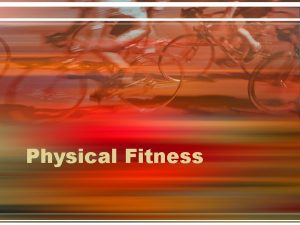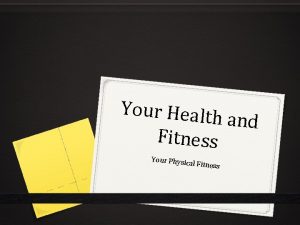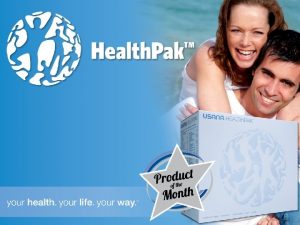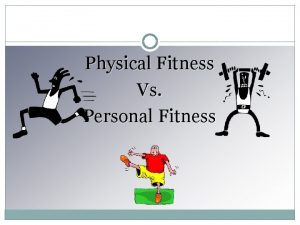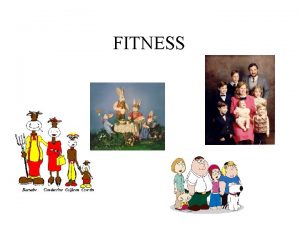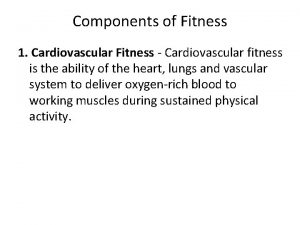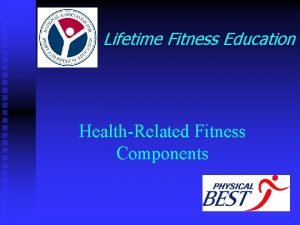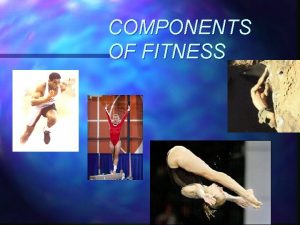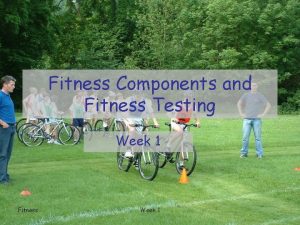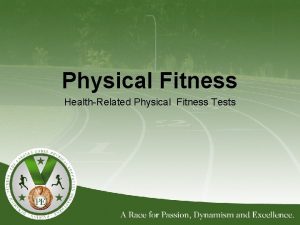Your Health Matters Fitness for Life 4 Fitness




































- Slides: 36

Your Health Matters: Fitness for Life 4: Fitness Basics 1

Showtime! Video Your Health Matters: Fitness for Life 2

What is physical activity? Physical activity = body movement that uses energy 3 USDA My. Pyramid; Be Active Your Way, U. S. Department of Health and Human Services 2008 Activity Guidelines for Americans

Benefits of regular activity ü Better health ü Live longer ü Less stress ü Less risk for disease ü Be in shape ü Balance, posture, flexibility ü Feel more energetic USDA My. Pyramid; Be Active Your Way, U. S. Department of Health and Human Services 2008 Activity Guidelines for Americans; American Heart Association; Canadian Society for Exercise Physiology 4

Benefits of regular activity ü Weight management ü Stronger bones, muscles, joints ü Feel better about yourself ü Get around better, independent ü Be with friends, meet new people ü Enjoy yourself and have fun ü Look good USDA My. Pyramid; Be Active Your Way, U. S. Department of Health and Human Services 2008 Activity Guidelines for Americans; American Heart Association; Canadian Society for Exercise Physiology 5

Risks of inactivity Ø Premature death Ø Heart disease Ø Type 2 diabetes Ø High blood pressure Ø High cholesterol Ø Stroke Ø Obesity Ø Certain cancers Ø Osteoporosis Ø Depression Ø Anxiety 6 Centers for Disease Control and Prevention, Canadian Society for Exercise Physiology; American Cancer Society

The major muscle groups are used in physical fitness whether it be for muscular strength, muscular endurance, Cardio-Respitory Endurance, or Flexibility. (Large muscle in upper middle back) (Top of shoulder) (Front of upper arm) Oblique (Front of upper chest) (Triangular (Side of body) (Abdomen) (Front of thigh) muscle in middle of back) (Back of upper arm) Erector Spinae (Lower back) (Buttocks) (Back of thigh) (Calf/back of lower leg) 7

Strength Training Exercise Major Muscle groups used Arm Curls upper arms (biceps & triceps) Overhead Arm Raise Deltoids (shoulder), triceps & biceps Front Arm Raise Deltoids (shoulder) and Pectoralis (chest) Side Arm Raise Triceps, Deltoids (arms & shoulders) and Obliques (side) Seated row Latissimus Dorsi, Erector Spinae (back), biceps and triceps (arms) Back leg raise Quadriceps, Hamstrings and Gastrocnemius (Thigh and calf) Leg curls Quadriceps, Hamstrings and Gastrocnemius (thigh and calf) Side leg raise Abductors , Adductors (muscles to move away from & toward the body) and Gluteus (buttocks) 8

Three types of exercise are: • Weight-bearing • Resistance • Flexibility Web MD. com 9

Weight-bearing Exercise • Weight-bearing means your feet and legs support your body’s weight. A few examples of weight-bearing exercise are: • Walking • Hiking • Dancing • Stair climbing • Sports like bicycling and swimming are great for your heart and lungs. However, these are not weightbearing exercise. That’s because you are being held up by something other than your feet and legs, such as the bicycle or the water. Web MD. com 10

Resistance Exercise • Resistance means you’re working against the weight of another object. Resistance helps because it strengthens muscle and builds bone. Studies have shown that resistance exercise increases bone density and reduces the risk of fractures. • Resistance exercise includes: – Free weights or weight machines at home or in the gym – Resistance tubing that comes in a variety of strengths – Water exercises -- any movement done in the water makes your muscles work harder. Web MD. com 11

Flexibility Exercise • Flexibility is another important form of exercise. Having flexible joints helps prevent injury. • Examples of flexibility exercise include these: – Regular stretches – T'ai chi – Yoga Web MD. com 12

Sample Strength Training routine • Warm up – 5 -10 minutes walk briskly, stretch muscles • Strength training exercises – Complete 1 -2 sets of 10 -12 reputations of any of the strength training exercises • Cool down – 10 -15 minutes of stretching muscles, balance and breathing exercises 13

Strength Training Tips • Important to always rotate the days of exercise for major muscle groups. So alternate the days of strength training with the days of cardio or aerobic exercise. One day on, One day off! • Always breathe! Breathe out as you lift and breathe in as you relax. • No fast movements-Always complete the movement. • Always start with a light weight and slowly increase weight. When it is too easy to complete 2 sets of 10 -12 repetitions at one weight, increase to the next weight. 14

Different types of 10 -15 min activities focusing on body strength ACTIVITY (basic strength & aerobic in one) • • 10 – 15 lunges 10 -15 push ups 10 -15 sit ups 10 -15 jumping jacks All of these work the upper body, abdomen and quadriceps. Refer to Exercise & Physical Activity Guide in back of section 15

Physical Activity Pyramid Cutting down on computer and TV time and moving more Strength Training and Flexibility Cardio/Aerobic and Recreational Activities Everyday Life 16 Wellspan. Health Web site

Calories OUT: Activity Guidelines “FITT” Frequency Intensity Time Type 17 Centers for Disease Control and Prevention; National Heart Lung and Blood Institute

Calories OUT: Activity Guidelines Frequency How often you are physically active Centers for Disease Control and Prevention; National Heart Lung and Blood Institute 18

Calories OUT: Activity Guidelines Centers for Disease Control and Prevention; National Heart Lung and Blood Institute Intensity Your level of physical activity 19

Examples of Activity LIGHT-INTENSITY • Grocery shopping • Cleaning house MODERATE-INTENSITY • Biking less than 10 miles per hour • Light yard work (rake, trim) • Ballroom/line dancing • Catch & throw sports • Water aerobics Focus on moderate- and vigorous-intensity activities VIGOROUS-INTENSITY • Biking more than 10 miles per hour • Heavy yard work (dig, hoe) • Aerobic/fast dancing • Sports with running (soccer, basketball, hockey) • Jumping rope Be Active Your Way, U. S. Department of Health and Human Services 2008 Activity Guidelines for Americans 20

MODERATE-INTENSITY ACTIVITY Calories used in 1 hour* Calories used in 30 minutes* Dancing 330 165 Bicycling (less than 10 mph) 290 145 Walking (3½ mph) 280 140 Weight training 220 110 Stretching 180 90 *For a 154 -pound man (5’ 10”) USDA My. Pyramid 21 Centers for Disease Control and Prevention

VIGOROUS-INTENSITY ACTIVITY Calories used in 1 hour* Calories used in 30 minutes* Heavy yard work (chop wood) 440 220 Aerobics 480 240 Bicycling (more than 10 mph) 590 295 Jogging (5 mph) 590 295 Swimming (slow freestyle laps) 510 255 Basketball 440 220 *For a 154 -pound man (5’ 10”) USDA My. Pyramid 22 Centers for Disease Control and Prevention

DAILY LIVING ACTIVITY Time & Frequency Pounds lost per year* Walk briskly part of the way to/from work/home 10 min 5 X/week 4 Use the stairs whenever possible 5 min 5 X/week 2 Take a brisk walk during your lunch break 10 min 5 X/week 4 Ride stationary bike while reading/listening to music 10 min 5 X/week 5 Play actively with your children 15 min 7 X/week 7 *For a 154 -pound person Fitting Fitness In 23 Centers for Disease Control and Prevention

Calories OUT: Activity Guidelines Time How long you are physically active Adults: At least 30 minutes most days – at least 10 minutes at a time Children: At least 60 minutes per day Centers for Disease Control and Prevention; National Heart Lung and Blood Institute 24

Guidelines for important health benefits Adults need: Aerobic/Cardio Activity At least 150 minutes per week and Muscle-strengthening & Flexibility Training 2 days per week Centers for Disease Control and Prevention 25

Guidelines for important health benefits Children need age-appropriate activity at least 60 minutes per day National Association for Sports and Physical Education; Centers for Disease Control and Prevention 26

Calories OUT: Activity Guidelines Type aerobic or strength training Centers for Disease Control and Prevention; National Heart Lung and Blood Institute 27

How much activity do you need? For general health, adults need 30 minutes most days. More intensity and time is needed for weight loss. AEROBIC ACTIVITY • Moderate-intensity: faster heart beat – can talk easily • Vigorous-intensity: stronger heart beat – difficult to talk HOW MUCH? • Moderate-intensity: 150 minutes/week -OR • Vigorous-intensity: 75 minutes/week • Periods of 10 minutes or more Some activity is better than none! 28 Be Active Your Way, U. S. Department of Health and Human Services 2008 Activity Guidelines for Americans; Centers for Disease Control and Prevention; National Heart Lung and Blood Institute; American Cancer Society

How much activity do you need? For general health, adults need strengthening 2 days a week. MUSCLE STRENGTH TRAINING • Makes muscles stronger • Keeps muscle tissue lean • Examples: lift weights; push-ups, yoga HOW MUCH? • 2 days or more per week • Include all major muscle groups: legs, hips, back, chest, stomach (abs), shoulders, arms • 10 -15 repetitions 29 Be Active Your Way - U. S. Department of Health and Human Services 2008 Activity Guidelines for Americans; Centers for Disease Control and Prevention; National Heart Lung and Blood Institute; Go 4 Life Exercise Guide - National Institute on Aging

Avoiding Injury To stay safe while exercising: • Start slowly and build up. • Learn what’s right for you. • Choose activities that fit your fitness level. • As you become more active, add more time to activities before switching to different ones. • Use the right equipment and gear. • Choose a safe place to exercise. • If you have a health problem, see your doctor. 30 Be Active Your Way, U. S. Department of Health and Human Services 2008 Activity Guidelines for Americans

Make Activity Part of Your Life Ø Plan your activity for the week. Ø Find the time that works best for you. Ø Choose activities you like that fit into your life. Ø Be active with friends and family. Ø Every bit of activity adds up—doing something is better than doing nothing. Ø If you’re just getting started, work your way up. 31 Be Active Your Way, U. S. Department of Health and Human Services 2008 Activity Guidelines for Americans

Activity: Brainstorming • Name three reasons that being physically active is fun. • Name three ways of adding physical activity into family’s daily lives. • Name three ways to free you and your family from watching so much TV. 32

Keep Track Each Week Refer to back of section 33 Be Active Your Way, U. S. Department of Health and Human Services 2008 Activity Guidelines for Americans

Let’s move! 10 -minute Activity Break 34

Fitness Basics Key Point Recap Ø Choose moderate-intensity or vigorous-intensity activities, or a mix. Ø Do at least 150 minutes each week of aerobic activity. Ø Also do muscle strengthening and flexibility at least two days per week. Ø Start slow and strive to double your weekly time for more health benefits. 35

Switch to How to Get Started and Stay Active Power. Point 36
 Health vs skill related fitness
Health vs skill related fitness Fitness chapter 6
Fitness chapter 6 Health matters paragraph
Health matters paragraph Health matters amesbury
Health matters amesbury Living a life that matters
Living a life that matters Inner wellbeing
Inner wellbeing Carebridge trinity health
Carebridge trinity health Your health is your responsibility
Your health is your responsibility Change your water change your life
Change your water change your life Give us your hungry your tired your poor
Give us your hungry your tired your poor Iso 22301 utbildning
Iso 22301 utbildning Typiska novell drag
Typiska novell drag Tack för att ni lyssnade bild
Tack för att ni lyssnade bild Ekologiskt fotavtryck
Ekologiskt fotavtryck Varför kallas perioden 1918-1939 för mellankrigstiden
Varför kallas perioden 1918-1939 för mellankrigstiden En lathund för arbete med kontinuitetshantering
En lathund för arbete med kontinuitetshantering Kassaregister ideell förening
Kassaregister ideell förening Tidbok för yrkesförare
Tidbok för yrkesförare A gastrica
A gastrica Förklara densitet för barn
Förklara densitet för barn Datorkunskap för nybörjare
Datorkunskap för nybörjare Boverket ka
Boverket ka Debattinlägg mall
Debattinlägg mall För och nackdelar med firo
För och nackdelar med firo Nyckelkompetenser för livslångt lärande
Nyckelkompetenser för livslångt lärande Påbyggnader för flakfordon
Påbyggnader för flakfordon Lufttryck formel
Lufttryck formel Svenskt ramverk för digital samverkan
Svenskt ramverk för digital samverkan Kyssande vind
Kyssande vind Presentera för publik crossboss
Presentera för publik crossboss Argument för teckenspråk som minoritetsspråk
Argument för teckenspråk som minoritetsspråk Bat mitza
Bat mitza Klassificeringsstruktur för kommunala verksamheter
Klassificeringsstruktur för kommunala verksamheter Epiteltyper
Epiteltyper Bästa kameran för astrofoto
Bästa kameran för astrofoto Cks
Cks Lågenergihus nyproduktion
Lågenergihus nyproduktion

